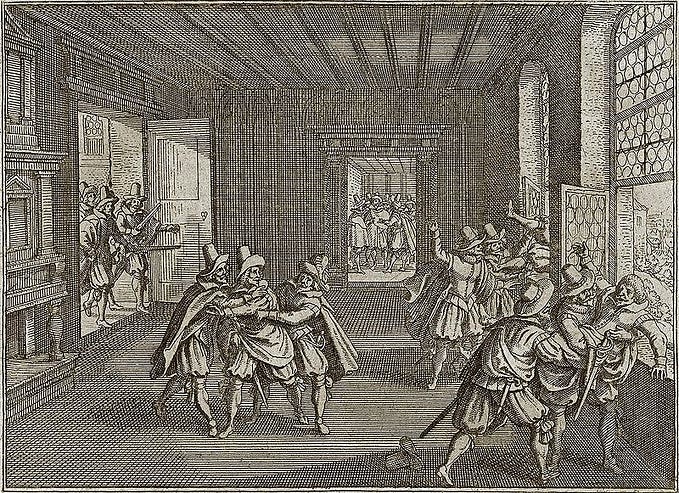The Billion-Dollar Party That Ended a 2500-Year-Old Monarchy
How the biggest and most expensive party in modern history cost the Shah of Iran his crown
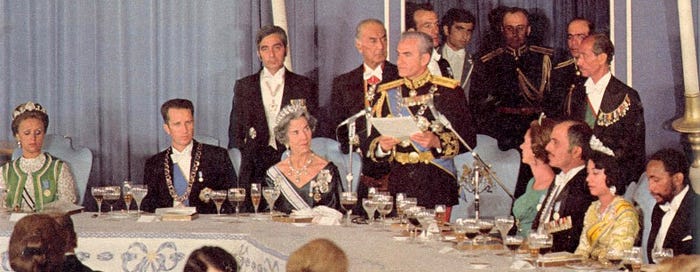
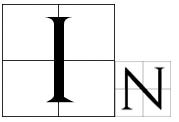 In October 1971, in the middle of the Iranian desert, the largest meeting of monarchs and heads of state in modern history took place. The party was to celebrate the 2500th anniversary of the founding of the Persian empire and its host, Shah Mohammed Reza Pahlavi of Iran, spent hundreds of millions of dollars to impress them. Air conditioned tents, roasted peacock, and gallons of champagne were all on offer within a specially-made artificial oasis. But the three-day celebrations cost the Shah more than mere money… it cost him his crown.
In October 1971, in the middle of the Iranian desert, the largest meeting of monarchs and heads of state in modern history took place. The party was to celebrate the 2500th anniversary of the founding of the Persian empire and its host, Shah Mohammed Reza Pahlavi of Iran, spent hundreds of millions of dollars to impress them. Air conditioned tents, roasted peacock, and gallons of champagne were all on offer within a specially-made artificial oasis. But the three-day celebrations cost the Shah more than mere money… it cost him his crown.
Reza’s Iran
Shah Mohammed Reza Pahlavi was the head of a 2,500-year-old dynasty as Shahanshah “King of Kings”. His absolute power over the Iranian government stemmed from 1953's Operation Ajax. In 1951, Iran’s popular Prime Minister nationalised the country’s oil, denying access to America and Britain. The Shah was paid $1 million to lead an Anglo-American-backed coup that overthrew the Prime Minister and re-installed him as supreme leader.
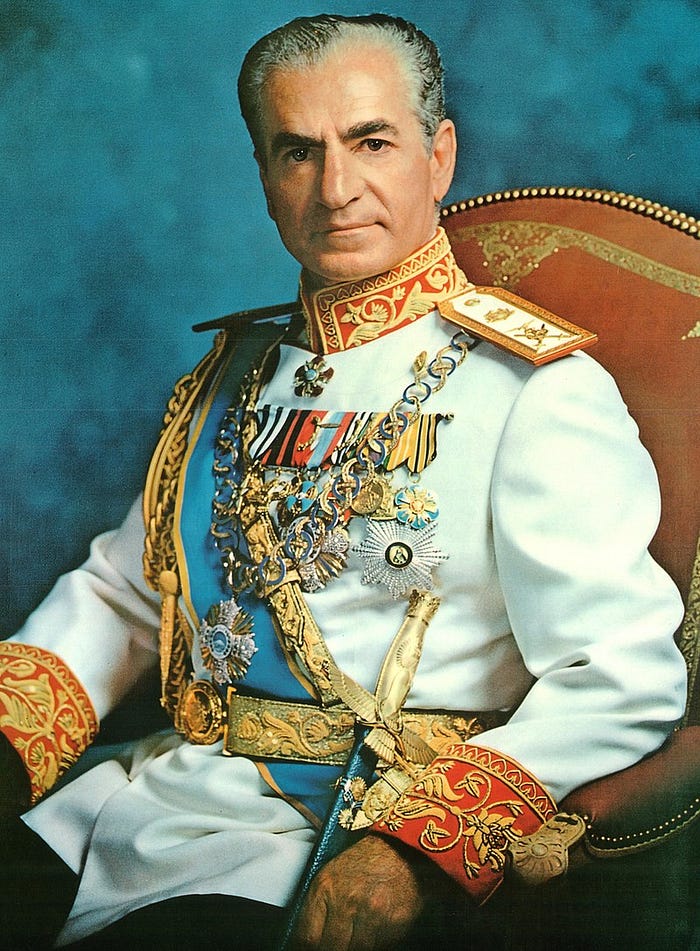
In 1963, the Shah launched his ‘White Revolution’, aimed at modernising Iran. Greater freedoms were given to women, land was redistributed, nuclear facilities were constructed, and an industrialist class grew from the boom in goods manufacturing.
But behind this vision of modernity was a harsh reality. The Shah’s reforms were unpopular with many Muslim clerics and conservative subjects, but he ensured their voices were never heard. Few civil liberties existed; the SAVAK, Iran’s brutal secret service, would arrest and torture suspects at will, and by 1971 Iran had the highest number of political prisoners and official executions in the world.
51% of the population lived below the poverty line. Cities lacked infrastructure and rural communities lacked even basic needs like water, education, and medical care.
But the Shah was busy with other ideas. 1971 would mark 2,500 years since the founding of the First Persian Empire by Cyrus the Great and he viewed it as an opportunity to showcase his new Iran to the world and show himself as the ‘New Cyrus’.
In September 1970, the Shah announced a lavish three-day celebration would be held in the ruins of Persepolis, the capital of the old Persian empire, for all the great leaders of the world. There they would marvel at Iran’s past and pay homage to him as ‘King of Kings’.
Venue
Iran, viewed by many in the western world as a backwater, did not have the infrastructure or hotels to accommodate sixty heads of state and the countless staff and media required to run the event.
Instead, the Shah decided to construct his own oasis in the middle of a desert, far away from Iran’s troubles.15,000 trees and 15,000 flowers were imported from across Europe, some from the gardens of Versailles, to create the lush oasis. Whilst the rest of Iran was suffering a severe drought, the Shah was pouring gallons of water a day into the site, even commissioning the gardener of Versailles to create a perfumed garden of roses.
To save the distinguished guests from being bitten or stung, all the thousands of scorpions and snakes within a 30km area were exterminated with pesticides. To replace them in the Tent City, 50,000 songbirds were imported from Europe (including 20,000 Spanish sparrows); but many of these died in the intense temperatures of the Iranian desert.
Despite the whole party’s purpose being to exhibit Iranian history, style, and culture, few few Iranian craftsmen took part in its construction. The Shah insisted on using ‘world-class’ artisans and outsourced much of the work to France.
The Shah commissioned the legendary Maison Jansen of Paris to construct a great ‘Tent City’ to accommodate his guests . It took hundreds of French designers and builders over a year to create the fifty ‘tents’ (prefabricated apartments with Persian tent surrounds) on an airstrip outside Paris. Each one was fully air-conditioned and contained two bedrooms, two bathrooms, a lounge, a kitchen, and a full staff.
These tents were placed on five avenues (representing the five continents) radiating out from a central fountain. The Tent City also consisted of a ‘Tent of Honour’, where the Shah would receive his guests, the banqueting tent (the largest on the site),and a full 18-hole golf course. One tent contained sixteen hair salons and four beauty parlours (staffed by Parisian stylists) whilst another acted as a social club with a bar, cabaret suite, and even a secret gambling room.
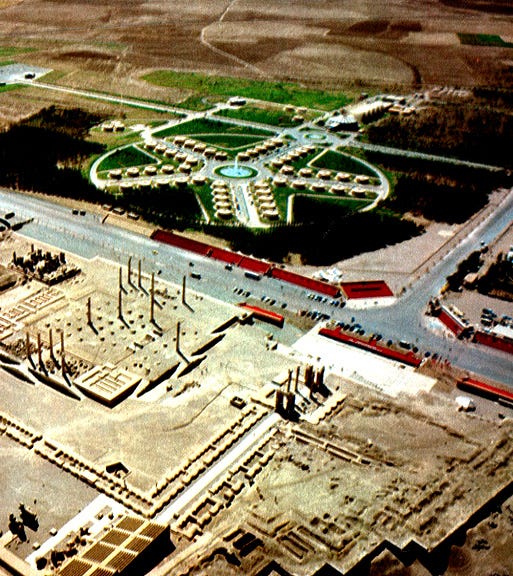
Food
The Shah equally spared no expense when it came to the food he intended to serve. He chose Maxim’s of Paris, believed to be the best restaurant in the world, to cater the entire event. They closed all their restaurants for a fortnight to fly all their staff to Iran.
To transport all the food and equipment to the middle of the Iranian desert, the Shah built an entire airfield in Shiraz and a 100km road connecting it to Persepolis. 100 aeroplanes from the Imperial Iranian Air Force took six months to transport over 18 tons of food and drink.
This included 380 thousand eggs, 30kg of caviar, 2,700kg of pork, beef, and lamb; 12 tons of wine, champagne and spirits, and, to keep the drinks cold, ice cubes the size of garages.
Security
This was to be the largest gathering of international royalty and world leaders in modern history and the Shah already had a huge popularity problem. Protests against the party rose up as soon as plans were announced and the SAVAK believed terrorists were setting up in the mountains surrounding Persepolis.
65,000 soldiers and SAVAK officers were mobilised to protect the Tent City and prevent any disturbance that could embarrass him. Checkpoints were positioned every few metres along the road to Persepolis (at one of which the King of Denmark was thrown out of his car) and the banqueting hall was strictly prohibited to authorised Maxim’s staff only, to prevent the poisoning of guests.
On top of this, Iran’s entire border was closed for the duration of the party. All universities and colleges were closed and student groups disbanded. Thousands of political activists and student leaders were rounded up by the SAVAK and placed in ‘protective custody’ in cells so crowded they could barely lay down.
In October 1971, after thirteen months of preparation, the stage was finally set. The Ministry of Agriculture planted pine trees along the road from Shiraz to Persepolis and the National Iranian Oil Company installed torches to light the way with elaborate displays. The Shah’s dream had become a reality.
The Party Begins
The anniversary celebrations began on 12 October, with a homage to the spirit of Cyrus the Great at his tomb at Pasargadae. The Shah, Shahbanu Farah and Crown Prince Reza, all in full imperial costume, processed in state to the mausoleum where the Shah delivered an impassioned speech to his great predecessor. He promised that Iranians would ‘prove worthy heirs of their glorious past’ and told Cyrus to ‘rest in peace for we are awake, and we will always stay awake’.
That afternoon and for the next two days, the Shah’s distinguished guests arrived. The guest list was perhaps the most prestigious in history, including eighteen presidents, eight kings, and an emperor.
Guest List
- Vice President Agnew of the USA (President Nixon was not given CIA clearance)
- Chairman Podgorny of the USSR
- President Jonas of Austria, President Zhivkov of Bulgaria, President Medici of Brazil, President Kekkohen of Finland, President Sunay of Turkey, President Losonczi of Hungary, President Suharto of Indonesia, President Svoboda of Czechoslovakia, President Khan of Pakistan, President Franjieh of Lebanon, President Fouche of South Africa, President Senghor of Senegal, President Giri of India, President Daddah of Mauritania, President Maga of Dahomey, President Ceauşescu of Romania, President Seko of Zaire, and President Gnägi of Switzerland
- Prime Minister Chaban-Delmas of France, Prime Minister Kim of South Korea, Prime Minister Colombo of Italy, and Prime Minister Makhosini of Swaziland
- Chief Earl Old Person of the Blackfeet Nation
- First Lady Imelda Marcos of Indonesia
- Governor-General Michener of Canada and Governor-General Hasluck of Australia
- King Frederick IX of Denmark, King Baudouin of Belgium, King Hussein of Jordan, King Mahendra of Nepal, King Olav V of Norway, King Konstantinos II of Greece, King Moshoeshoe II of Lesotho, and King Tunku of Malaysia
- Emir of Bahrain, Emir of Kuwait, Emir of Qatar, Emir of Abu Dhabi, and the Sultan of Oman
- Prince Franz Josef II of Liechtenstein, Prince Rainer III of Monaco, Grand Duke Jean of Luxemburg, Prince Bernhard of the Netherlands, Crown Prince Carl Gustaf of Sweden, Prince Victor Emmanuel of Italy, Prince Takahito of Japan, and Prince Moulay Abdallah of Morocco
- Prince Philip, Duke of Edinburgh (It was decided it would be inappropriate for Queen Elizabeth II to be seen paying homage to the ‘King of Kings’)
- Emperor Haile Selassie of Ethiopia
The Shah met many of these guests (especially his fellow monarchs) at the airport in Shiraz before a fleet of 250 bullet-proof limousines provided by Mercedes-Benz whisked them away to the Tent City in Persepolis.
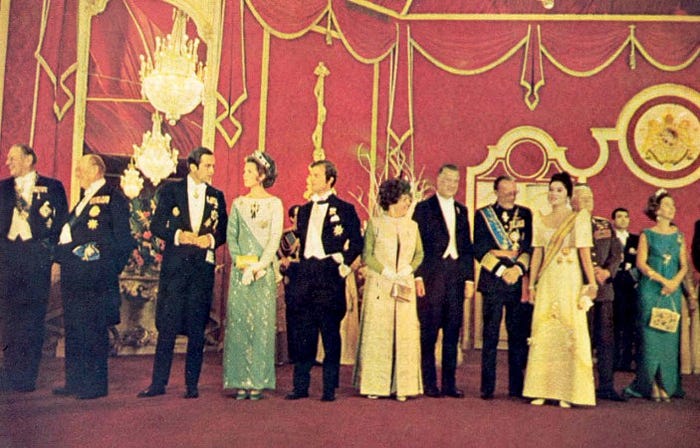
Journalists and staff later described the ‘surreal’ atmosphere of so many world leaders in one place. The Vice President of America would be smoking outside his tent and waving to the King of Sweden walking past, all while the First Lady of Yugoslavia was chatting to the Emir of Abu Dhabi. Most of the European monarchs were related and so would freely walk in and out of each other’s tents and hang out at the social club. The underground safe was crammed with tiaras, necklaces, and solid-gold jewellery; but the most expensive item in there was in fact the diamond-encrusted collar of the Emperor of Ethiopia’s dog.
The Banquet
On the evening of 14 October, the Shah hosted his guests to the most lavish dinner in modern history inside the enormous Banqueting Tent. The table was 70 metres long and its tablecloth took 150 women over six months to embroider.
The scene harked back to a 17th-century European court, with aide-de-camps announcing guests with evermore extravagant titles, the crystal chandeliers suspended from the ceiling, the gold-plated cutlery, the Limoges crockery, and the Baccarat crystal glasses.

Naturally, Maxim’s had understood the Shah’s commission and composed the most delicious menu in the world:
- Entre: Quails Eggs stuffed with Iranian Caviar
- First Course: Crayfish Mousse with Nantua Sauce
- Second Course: Roast Saddle of French Lamb stuffed with Mushrooms, Truffles, and Foie Gras
- Sorbet of Moet Champagne
- Main Course: ‘Imperial Peacock Surrounded by its Court’ with a Nut and Truffle Salad. (Not actually peacock but quail stuffed with truffles and foie gras and presented inside 50 peacocks)
- Dessert: Glazed Oporto Figs with Cream and Raspberry Champagne Sherbet
- Coffee and Cognac Prince Eugène
All this was washed down with 2,500 bottles of champagne, 1,000 bottles of wine, and 1,000 bottles of Burgundy.
With a menu worth millions, 600 guests (including 60 heads of state), and lasting over six hours, the Shah’s banquet remains to this day the grandest and longest dinner in history according to the Guinness Book of World Records.
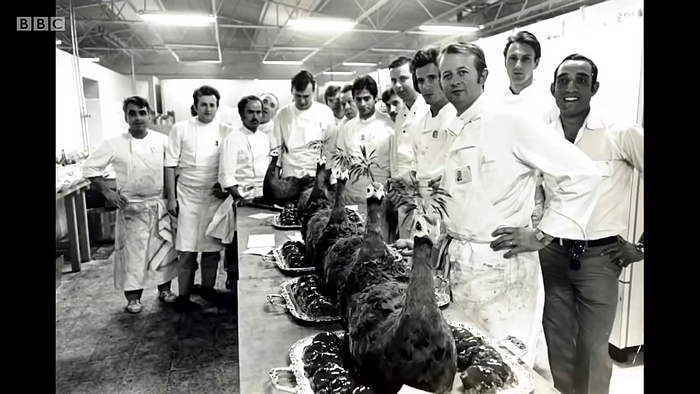
After the banquet, the guests made their way to the Persepolis ruins where a light and sound display was projected onto the archaic columns and statues, narrated by the voices of the great shahs of the past. After the show, the surprise fireworks display came as such a surprise that many of the guests believed the party was under terrorist attack.
The Parade
The following morning, 15 October, brought the main event. A parade of 1,724 soldiers and performers reenacting 2,500 years of Persian history, complete with horses and camels.
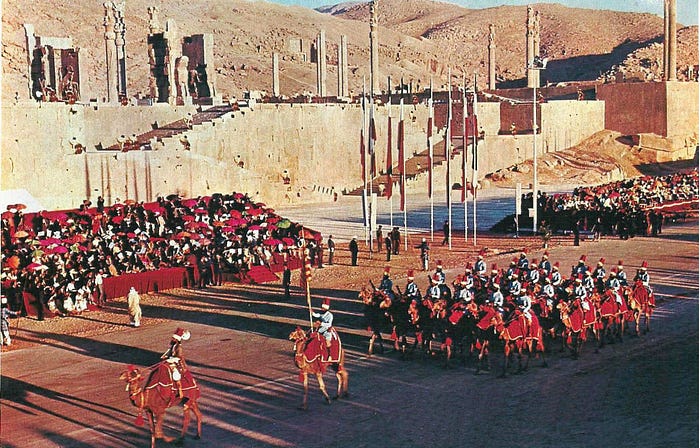
The Shah ensured that no expense was spared on research. Trumpets and other instruments were made and played that had not been heard for centuries. The costumes were painstakingly studied for months by international military historians and built by military outfitters in Tehran. Even three life-size ships were constructed from the reigns of Xerxes and Darius the Great.
The 16 October marked the end of festivities for many guests as they left for Shiraz. Those that remained were carted to Tehran for three more days of celebrations.
A Doomed Legacy
In terms of international prestige, the party certainly achieved all the Shah wished for. The wealth and glorious history of Iran was screened all over the world, and the world was certainly impressed; Time magazine called it ‘the greatest gathering of the century’. The Shah’s fellow monarchs were either humbly impressed or atrociously jealous. For those three days, the Shah really was Shahanshah, the King of Kings.
But the people whose opinion really mattered, the Iranian public, were outraged.
First was the apparent lack of feeling. Whilst 51% of his subjects were starving and his country was experiencing a drought, the Shah was parading in an artificial oasis and feasting on truffles. All while his secret service had shut down universities and imprisoned thousands of suspects.
Then there was the significant lack of Iranians. As aforementioned, very few Iranian craftsmen toom part in the construction of the Tent City. The food the Shah served was all French and cooked by French chefs. Even at his 600-person banquet, the Shah invited barely any of his own ministers, only a select few Iranians who had taken part in the planning were invited. Indeed, when the specially-commissioned feature film of the event was shown to him, even the Shah asked, “Where are the Iranians?” Thus, the party was less a show of Iranian culture and history and far more an excuse for the Shah to show off for his rich and entitled friends.
Thirdly was the shocking debauchery of the party. A devoutly Islamic country, much of the population was outraged to find the banquet drowning in alcohol, with female guests wearing short dresses, and not to mention the Shah’s devilish gambling den in the social club. Ruhollah Khomeini, a Muslim cleric then exiled in Iraq called it ‘the Devil’s festival’ and the ‘most catastrophic’ of the Shah’s many ‘shameful festivities’.
Finally, there was the cost. Predictions vary as the the total cost of the celebrations; Time magazine put it at $100 million ($635 million today), Le Figaro doubled that to $200 million ($1.2 billion today), whilst the Iranian press argued it could not have cost less than $500 million ($3 billion today). The Shah placed the official figure at only $16.8 million ($112 million today), and argued that donations from the visitors went towards the creation of 3,200 rural schools.
But whatever the monetary cost, the true price the Shah had to pay for his party was his crown. The event united the opposition parties against him and lost him all his public credibility. So great was the public discontent that in 1974 the Shah actually apologised for the party and his past wrongdoings.
But it was all too late. The popular protests of the late 1970s grew into the Islamic Revolution. In February 1979, pro-Khomeini forces overthrew the government and established the Islamic Republic with Khomeini as its Supreme Leader. The Shah was exiled to Egypt and died the following year, ending two-and-a-half millennia of Iranian monarchy.




